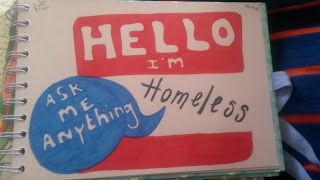Transatlantic Practice Exchange: Reflections on a US Shelter Visit
In April 2017 I spent two weeks in Grand Rapids, Michigan, as part of the Transatlantic Practice Exchange, find me on twitter @ruthfranciszka and follow #homelesslearning
Whilst I was in Grand Rapids I had my first experience of
the American Shelter system, I visited Mel Trotter Ministries, a Christian
shelter and the largest provider of emergency accommodation in the city, over
300 homeless, men, women and families sleep there every night.
One of the
biggest culture shocks I experienced during my time in the US was the
difference in the systems supporting family homelessness. In the UK families
with dependent children are considered in priority need and by law must be
given emergency accommodation until permanent housing is secured; in the US there
is no equivalent legislation; there are a shortage of family shelter beds and it
is not uncommon for families, with children to rough sleep.
At Mel Trotter the family and women’s emergency shelters are
set up as individual bed sits or small dormitories, whereas the men’s shelter
is set up as one large dormitory made up of over 180 bunk beds that are fully
occupied every night.
When I visited during the day dormitory was empty, but it
was easy to imagine the noise and commotion that 180 people living in such
close quarters must create. As with most shelters of this scale outbreaks of
bed bugs are common; as a result, personal belongings of residents on the
family, women’s and youth sides of the building are treated overnight in a
specialist heat treatment facility. Men’s belongings are not treated, but are surrendered
at the door for collection the following morning.
The ministry offers a variety of faith based programmes; including
vitamin based none-medical detoxes and programmes geared towards employment or
addiction recovery.
If participants choose to enter one of these programmes they
are able to move out of the large communal dormitory to a smaller dormitory
where they can keep their belongings with them and secure a regular bed without
queueing outside on a nightly basis. Further involvement in programmes can lead
to moving up to a higher floor of the building where participants have their
own apartment style rooms.
The ministry offers separate accommodation for unaccompanied
young homeless men (aged 18-24) unaccompanied young women live within the main
female population. There is move on accommodation available to some of the
young people, they pay a subsidised rent, and a portion of this is placed in a
savings account for the young people to use as a future security deposit.
Many of the organisation’s services, such as catering are
funded through donations and are provided by volunteers, although the ministry
does not offer any paid employment options to its participants, it does offer
letters of reference for homeless volunteers leaving the programme and seeking
employment.
The ministry also runs the Public Inebriate Shelter where
community members who are publicly drunk can be bought, up to several times a
day, to sober up, shower, eat and sleep. People accessing the clinic are
offered sign posting to substance misuse services and access to faith based
recovery is strongly encouraged. The public inebriate service is designed to
reduce the cost and burden on Accident and Emergency services and is supervised
by registered nurses.
As well as the clinic the ministry offers free medical care
services, such as dentistry and optometry to the wider community as well as
shelter residents. In the US access to medical care is generally restricted to
those who can afford to pay for health insurance and even an emergency
ambulance journey carries a cost to the patient; as a result these free
services are a vital resource, not just to the homeless population, but to low
income households across Grand Rapids.
The sheer scale of Mel Trotter ministries felt difficult to
apply to a UK context, however in some ways the model is not dissimilar to the UK
hostel or night shelter system; often participants move through a programme as
they are deemed to have reached a level of housing readiness. While housing
resources do not match demand, there is a vital place for emergency shelter,
however currently in both the UK and US most of our emergency accommodation
systems do not naturally support a strengths based approach; they rely on needs
led, deficit based assessment and require residents to prove housing readiness
before they can move on.
Community Rebuilders also offer emergency accommodation,
currently this is on a much smaller scale than the ministry and takes the form
of a fully furnished 5 bed house, specifically for homeless veterans. The house
belongs to a private landlord, CR have built a relationship with the landlord,
involving him in their mission to end veteran homelessness in Kent County, as a
result the property is finished and furnished to an incredibly high standard;
providing a calm, safe base for the residents to, with the support of their
Housing Resource Specialist, move on to their own tenancy. In comparison to the
emergency shelters I can’t help thinking how much easier concentrating on your
goals and planning the future would be in an environment like this.
*Photos taken during my exchange trip
More
Information about priority need for families and vulnerable groups in the UK http://england.shelter.org.uk/get_advice/homelessness/help_from_the_council_when_homeless/priority_need
A
brief outline of the American medical system




Comments
Post a Comment